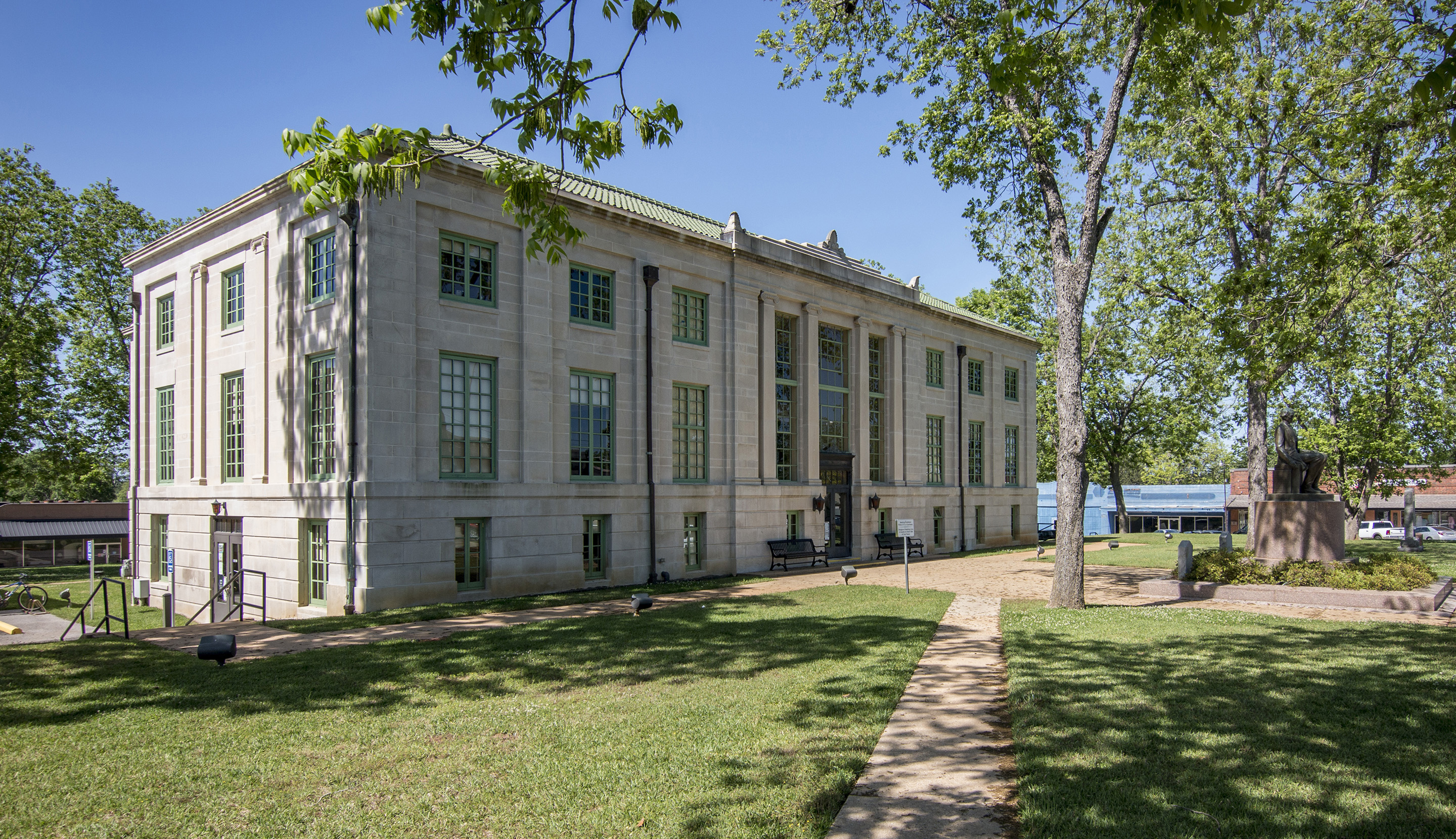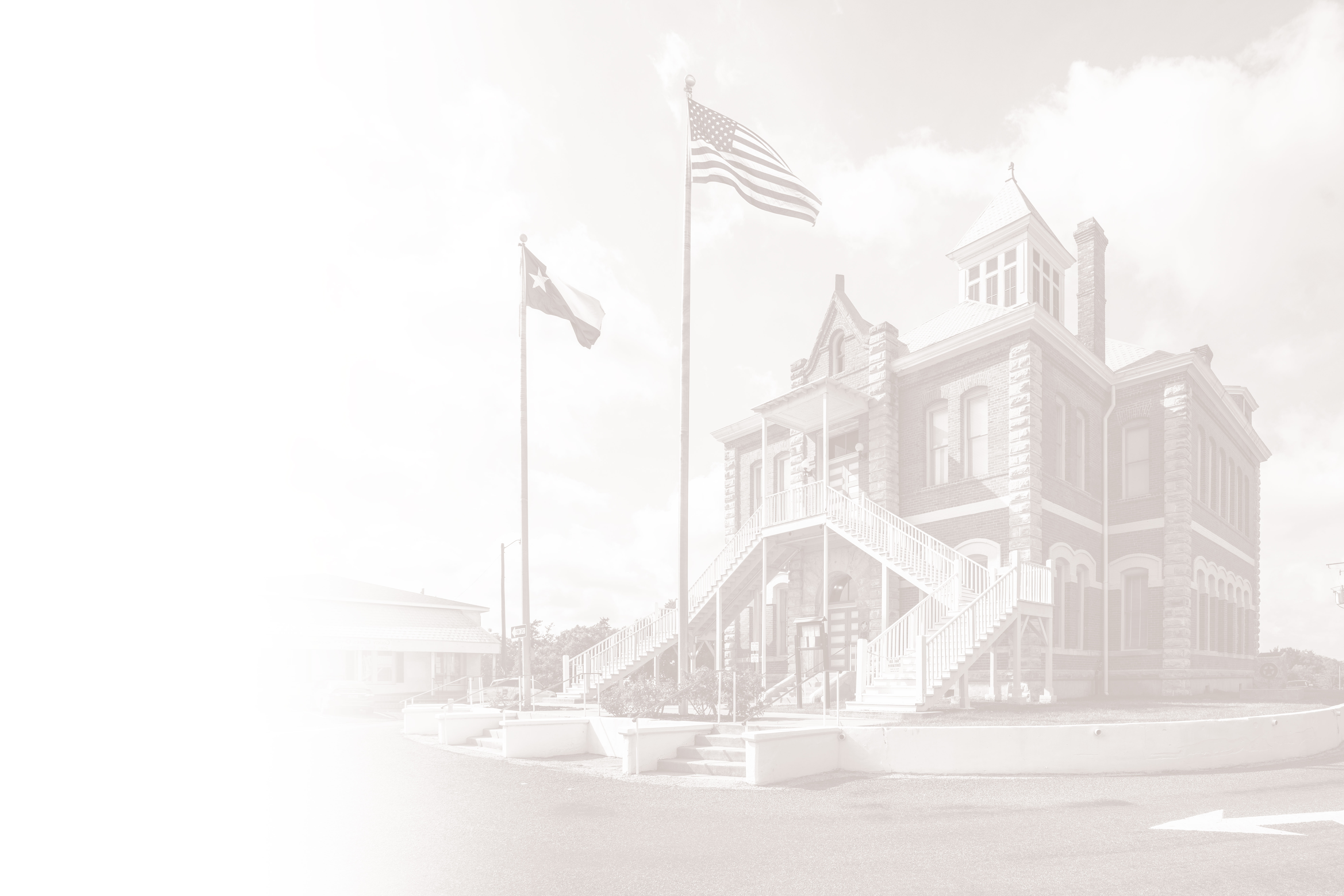
“There is no single event that has done more to revitalize and re-energize our community than the renovation of our County Courthouse… Small, rural Texas counties are the historical and cultural backbone of Texas. Without the valuable work being done by the Texas Historical Commission (and the courthouse restoration program) many of these counties will wither and die. That would be a tragic loss to all of Texas!”
—County Judge, Samye Johnson
"It's really the anchor of the county. It's the people's courthouse."
—Betty Oglesbee, San Augustine Garden Club
Architectural Description
The 1927 San Augustine County Courthouse’s Classical Revival style is characterized by a patinated bronze entry and transom surrounded by flat limestone pilasters, a matching pair of lanterns, and topped by a low pediment. This stripped Classical style shows the beginnings of a transition from the ornamental buildings at the turn of the century to a sleek, restrained style which would become popular during the 1930s and 40s. The construction consisted of concrete frame, with a Leuders limestone veneer, wood sash and steel frame windows, topped by a green Ludowicki tile roof.
The main entry opens to a split-level open lobby landing with faux-stone plaster walls, plaster scroll brackets, and terrazzo floors. The District Courtroom, located on the Second Floor, features two-story Palladian-style windows in one of the largest courtrooms in East Texas. The judge’s bench and spectator fixed seating are original furnishings.
Construction History
In 1833, the municipality that would become San Augustine was surveyed and platted in a city grid pattern that may have been the first of its kind in Texas. After the victory at San Jacinto, San Augustine was named the county seat for the Republic of Texas and incorporated in 1837. The customs office served as the center of justice until a two-story brick courthouse was built in 1854 two miles west of the original settlement at Ayish Bayou. In 1890, a fire destroyed much of the town. The old courthouse was demolished to make way for a new one on the courthouse square. By 1901, railroad tracks were laid to San Augustine that were eventually operated by the Santa Fe Railway, primarily to transport lumber to and from large sawmill operations. By 1914, the population reached 1,300. By the time the modern courthouse was built in 1927, city dwellers had access to municipal water, light and sewage services, as well as ice and natural gas. Following these boom times, San Augustine was hit with both the Great Depression and the decimation of timberlands that had been the economic backbone of the area.
Historical Designations
Listed on the National Register of Historic Places in 2004. Designated a State Antiquities Landmarks in 2005 and a Recorded Texas Historic Landmark in 2001.
Interesting facts:
- In April 1939, photographer Russell Lee came to San Augustine at the behest of the federally-funded Farm Security Administration. He documented small town life during the Depression years in San Augustine and Pie Town, New Mexico that were part of “the greatest documentary collection which has ever been assembled.” The photos (and others taken by John Vachon in 1943) proved to be invaluable to the restoration project effort.
- The 1927 courthouse was designed to be “fireproof.” Most interior materials were non-combustible, including the concrete frame, the clay tile infill walls, terrazzo and concrete flooring, and hollow metal frame windows in the County Clerk’s office.
- Ray Stripling, the Project Manager for J.E. Kingham Construction Company, is the son of famed restoration architect Raiford Stripling, whose office was located a block away from the courthouse square in the historic jail building. Ray is the grandson of San Augustine’s first pharmacist, who eventually served as San Augustine County Judge.
- The courthouse architect, Shirley Simons, attended Rice Institute (now Rice University) in Houston before opening an architectural practice in Lufkin in 1922. In 1928, he followed the East Texas oil boom to Tyler where his business flourished, designing the U.S. Post Office and Federal Building there in the 1930s and the Tyler City Hall. One of Simon’s employees from the 1930s went on to found an architectural firm in Lufkin, which eventually became Scott & Strong, the firm which restored the courthouse under the direction of Mark Strong.
Project Description
The restoration of the 1927 Classical Revival courthouse included restoring the original green tile roof and replacing the aluminum windows with wood casement windows, painted the historic green color to match the roof. The building's Leuders limestone exterior was cleaned and patched. All mechanical, electrical, plumbing, and fire-protection systems were replaced to meet modern standards. Walls and trim were painted with historic paint colors to complement the existing terrazzo floors, polished to the original luster. The County Courtroom was reconstructed, while improvements to the District Courtroom included installation of a new acoustical ceiling and sound system, restored lighting and fixed seating, and reconstruction of the gallery overlooking the space. Wall acoustic panels were added to the County Courtroom, while a special acoustic plaster replaced the District Courtroom ceiling, to improve functionality of these spaces. Several historic vault doors were fully-restored. The building became fully accessible for the first time.
Project Architect
Mark V. Strong, AIA of Scott & Strong Architects - Interior Design, Lufkin, Texas
Contractor
Ray Stripling, Project Manager, and Steve Wright, Site Superintendent, J.E. Kingham Construction Company of Nacogdoches, Texas
Innovations and Unique Discoveries:
- The faux-stone walls in the lobby area imitated the Leuders limestone walls on the exterior of the building. These walls and the ornate scroll brackets required expert guidance from a conservator to perfect the plaster techniques used in the 1927 construction.
- The terra cotta chair rails found throughout the corridors were originally painted bright green to imitate glazed tile and match the color of the roof tile and exterior paint trim.
- The pattern of screw holes in the terrazzo flooring of the county courtroom indicated that the fixed seating should be installed in the exact opposite direction envisioned earlier in the planning process by the design team. The room furnishings were turned 180 degrees to match the historical orientation during construction.
State Grant Program Participation
Through the Texas Historic Courthouse Preservation Program administered by the Texas Historical Commission, San Augustine County received a Planning Grant in 2004 for $90,093, followed by a Construction Grant in 2008 which eventually totaled $3,690,711.49. In all, San Augustine County received $3,780,804.49 in state grant funding.
County Preservation Leadership
The San Augustine Garden Club, led by Betty Oglesbee and others, raised the entire county match (over $650,000) through fund-raising and grant applications to foundations, particularly the T.L.L. Temple Foundation of Lufkin, Texas. They also supported the compilation of the Master Plan and paid for two conservation studies of the courthouse during the planning phase.
Mark Strong, of Scott & Strong Architects – Interior Designers, and Ray Stripling of J.E. Kingham Construction Company, both donated uncompensated time and energy to the project.
Rededication
A rededication ceremony was held on November 20, 2010 on the courthouse square in San Augustine. The highlight of the ceremony was recognition of about twenty members of the San Augustine Garden Club.
Links to Articles
See Texas Historical Commission’s Medallion (November/December 2010) article, “San Augustine County Courthouse Team Tackles Restoration of Historic Light Fixtures” (PDF).
Read more about the San Augustine County Courthouse restoration.
Nearby Places of Historical Interest:
- The Mission Dolores Visitors Center is located at 701 S. Broadway St. in San Augustine, the site of the 1720s Spanish mission (Nuestra Senora de los Dolores de los Ais) on El Camino Real and Ayish Bayou. It was abandoned in 1773, but has attracted archeological interest when it was “rediscovered” in the 1970s on “Mission Hill”.
- The 1920s Angus Theater/Museum Theater, at 110 E. Columbia St., houses the San Augustine County Historical Society. The theater is a Recorded Texas Historic Landmark.
- The Columns, a 1902 house operated as a bed-and-breakfast.
- San Augustine was designated an official Texas Main Street City in 2012. Tracy Cox is the Main Street Manager, located at 100 W. Columbia St., Room 301B, San Augustine, TX 75972. Phone: 936.275.3172.
- There are two National Register Historic Districts in San Augustine: the Residential District and the Commercial District. The Commercial District is roughly bounded by Main Street, Montgomery Street, Congres Street, Broadway Street, and Columbia Street.
- There are more than 100 historic cemeteries located throughout San Augustine County. See THC’s Historic Sites Atlas for information.
- For more information about historic places and events in this region, visit the Texas Forest Trail Region and the San Augustine County Historical Society.
- For more information about lodging, restaurants and businesses to help your visit be enjoyable, visit the San Augustine County Chamber of Commerce.

Is your courthouse in need of historic preservation?
Our nationally recognized and award-winning Texas Historic Courthouse Preservation Program has turned around the trend of disrepair and begun restoring these treasured historic landmarks.
Find out how we can help.